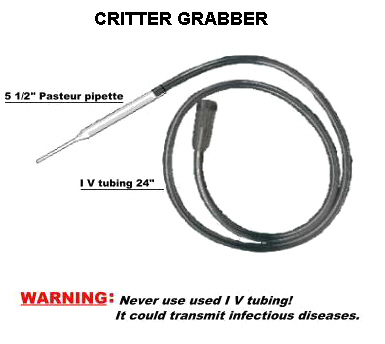One of the most frustrating aspects of microscopy is the fact that even the slightest movement on the part of the microscopist is magnified to disturbing proportions as we peer through the microscope.
You see something interesting at the edge of the field and when you try to move the slide to bring the subject into the center of the field your finger nudges the slide before you intended it to. This can be overcome by the use of a stage micrometer or by learning to move very slowly and deliberately when at the 'scope.
How do we deal with trying to select a single specimen out of a drop of water with a pipette?
It is hard enough to control the movement of the tip of a pipette which looks like the open end of a glass 55 gallon drum encroaching into the field of view. Now try to squeeze the rubber bulb on the end of the pipette without moving that barrel down there. Not all that easy to do.
There is a simple solution to this tasking problem. Get rid of the bulb!
That's right; get rid of it. Find a length of rubber or PVC tubing 24" long and fit it onto the back of the pipette. Place the free end of the tubing in your mouth and place the tip of your tongue against the end of the tube, (your tongue becomes the on - off valve). Now your hand is free to control the placement and movement of the tip of the pipette and to keep it positioned in one spot. (Placing a cotton wool plug in the tube near the mouth end will reduce the chances of ingesting liquid, but also see Safety Note below).
By releasing your tongue from the end of the tube and carefully sucking you will draw water, and your prey, into the pipette. Be careful not to suck the whole works up the tube and down your throat. This will take practice to learn how to do it right. I suggest that you practice with clean water and a bit of ground pepper or other such herb from the kitchen cupboard.
I find that this system works best if I place a grommet, or some such, on the free end of the tube. This gives me something to hold onto with my teeth while preventing the tube from closing off.
The illustration shows such a device made from a length of I V tubing. The bulb on the end of the tube is where the tube is connected to the I V bag. The other end of this tube fits snugly into the Pasteur pipette.
Gum rubber tubing is becoming hard to find here in this part of the U S A. I can pick up PVC tubing at yard sales and flea markets most of the time. The usual cost at yard sales is 25 cents for a 25 ft. Coil of tubing. NEVER....use I V tubing that has been used for administering an I V!!! Used IV tubing posses a very serious health hazard and should be disposed of in a proper fashion. In fact, I only buy tubing that is still sealed in the original packaging.
It does not take long to become proficient with this setup. After a little practice you will be slurping up little critters for slides and mono-cultures with ease.
Have fun, Thomas
Aungst.
